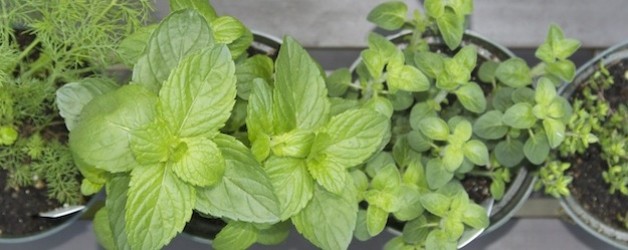

It is usually easy to find herbs that you want at the grocery store, but while it is a nice convenience, there are some great advantages to being able to snip off what you need for a recipe from your own herb plants. Cutting your own herbs will always give you fresher herbs, save you money, and reduce food waste, since you can just cut what you need instead of having to buy a whole bunch. It will also guarantee that your favorite herbs are available, and you will most likely use herbs more in your cooking and meals if they are as accessible as your kitchen counter or deck. In Part 1 on fresh herbs, we noted some of our favorite culinary herbs and ideas for how to store, dry, or freeze them. This week we give you some tips on how to grow your own.
Most of my friends know that I am not known for my green thumb. Although I would like to place the blame on the lack of direct sunlight on our yard, I haven’t had much success with plants. So, it was with some hesitation that I decided to try my hand at growing herbs. Let me tell you, if I can do it, so can you! I continue to learn more about herbs and how to grow them, so I am excited to share all the information I gathered. I had the added benefit of being at our local farmers’ market the past few weeks where so many of our vendors have herb plants started in small containers. So, in addition to buying some for myself, I asked around for tips and suggestions from as many people as I could. Whether you’ve grown herbs before or are new to it like I am, I hope some of this information will inspire you too!
I’ve grown my own herbs for years. Most of the time, I plant multiple herbs in pots on my patio or deck (depending on where I am living and where the sun is). I’m not much of a green thumb either, but I’ve always had success with herbs! In addition to using them in my cooking, I like to use herbs as a decorative garnish when serving foods.
General Guidelines for Growing Fresh Herbs
Since I learned so much by talking to people who grow herbs themselves, my best advice is to ask questions when you purchase seeds and/or herb starts to determine which plants will grow well under your specific conditions. A great online resource is The Herb Society of America.
Helpful tips for growing herbs:
- Choose which herbs you will use most often, and therefore want to plant. Our favorite culinary herbs are: basil, parsley, rosemary, cilantro, oregano, thyme, dill, tarragon, sage, and mint.
- Decide if you want to plant herbs in garden beds or in containers. Make sure either option has good drainage and ample sunlight to grow the herbs. 6+ hours/day is ideal.
- Basil, parsley, cilantro, and dill need to be cut back more often than you think to promote a more healthy, leafy plant. Don’t cut more than a 1/3 off the top of the plant at a time, and harvest these herbs before they flower for best flavor.
- Some herbs (rosemary and all mint varieties are examples) are pretty aggressive and can take over your garden or container, so it is best to plant these in their own container, or isolate them in the ground by planting them in a container that you can bury underground. (While the container will keep the herb from spreading, it will not be visible.)
- If purchasing herb starts rather than seeds, make sure they are not flowering and that there aren’t roots sticking out of the bottom of the container.
- Stagger the planting of herbs that need to be cut back often, like basil, parsley and cilantro, so you have a steady supply of leaves to use in your cooking.
- Herbs that you would think of as “Mediterranean,” like rosemary, oregano, and thyme don’t need as much water as other herbs.
Ina Garten’s Herb-Marinated Pork Tenderloin
This recipe in Barefoot Contessa Back to Basics by Ina Garten can be marinated ahead of time, and grilled or roasted in the oven (click on the recipe title for link to roasting instructions). The recipe is for 3 pork tenderloins so it is a great double batch dish if you have a small family.
- Grated zest of 1 lemon
- 3/4 cup freshly squeezed lemon juice (4-6 lemons)
- 1/2 cup good olive oil, plus extra for brushing the grill
- 2 tablespoons minced garlic (6 cloves)
- 1 1/2 tablespoons minced fresh rosemary leaves
- 1 tablespoons chopped fresh thyme leaves
- 2 teaspoon Dijon mustard
- Kosher salt
- 3 pork tenderloins (about 1 pound each)
- Freshly ground black pepper

Love the photograph! The information is great particularly since Kimberly confesses to her non-green thumb. It’s less intimidating. Great info! I can’t wait to use this pork recipe!!!! Sounds delish! I remember seeing herbs in water just like a bouquet of flowers on Sharon’s kitchen window sill often -ready to use. I do that all of the time now because it’s a wonderful way to grab and use and they look so pretty. Thanks! Good one!
Herbs as a kitchen bouquet – thanks for mentioning that up Jenn. Herbs do make great centerpieces or bouquets in kitchen and dill is especially pretty and fragrant.